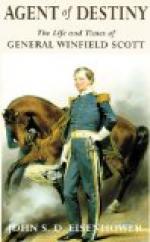General Scott’s wounds were so severe and painful that it was a long time before he was fit for duty. In September, 1814, Philadelphia and Baltimore were so threatened by the enemy that General Scott took nominal command for the defense of those cities. Everywhere on his route he received the highest evidences of the love and esteem of the people. At Princeton, N.J., he had a distinguished reception, and had conferred on him by the college the degree of Master of Arts. From Princeton he proceeded to Baltimore, and on October 16, 1814, assumed command of the Tenth Military District, with headquarters at Washington.
The treaty of peace was signed December 24, 1814, and ratified by the Senate, February 17, 1815. He was tendered the appointment of Secretary of War, but declined on the ground that he was too young. When his recommendations for colonel and brigadier general were presented to the President he expressed in both instances the fear that he was too young. It was in allusion to this that he gave this reason. He was then requested to act as Secretary until the arrival of William H. Crawford, at that period Minister to France, and who had been appointed Secretary of War. He declined this also, in deference to Generals Jacob Brown and Andrew Jackson. He was engaged for some time in reducing the army to a peace establishment, which being completed he was ordered to Europe for professional purposes. He was also intrusted with certain important and delicate diplomatic functions relating to the designs of Great Britain on the island of Cuba, and the revolutionary struggles between certain Spanish provinces in America.
CHAPTER III.
Is received and entertained by prominent civilians and military men in Europe—Marries Miss Mayo—Offspring—Thanks of Congress—Thanks of the Virginia Legislature voted, and also a sword—Controversy with General Andrew Jackson and correspondence—Prepares general regulations for the army and militia—Controversy with General Gaines and the War Department about rank—In command of the Eastern Division—War with the Sac and Fox Indians—Black Hawk—Cholera breaks out among the troops.
General Scott received great attention from prominent military men in Europe. He was also treated with much respect by men of letters and science. On his return home, in 1816, he was assigned to the command of the seaboard, and established his headquarters in the city of New York. On March 11, 1817, he was married to Miss Maria D. Mayo, of Richmond, Va., daughter of Colonel John Mayo. She was a lady of many accomplishments and a belle in Virginia society. The issue of this marriage who lived to maturity were Virginia, who died unmarried; Cornelia who was married to Colonel Henry L. Scott, General Scott’s adjutant general for many years, and who, dying, left one son, Winfield Scott, now a resident of Richmond, Va.; Camilla, who married Gould Hoyt, of New York, and died leaving children; Ella, who married Carroll McTavish, and has several daughters. She is now (1893) a resident of Baltimore. Mrs. Scott died June 10, 1862. Two sons and two daughters died before reaching maturity. Mrs. Scott’s remains were buried by the side of her illustrious husband at West Point.




